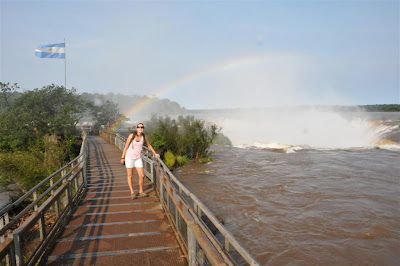
On Friday the 10th, we left the Laguna Blanca Estancia with Franco and Flaco, who we befriended during our stay at the Estancia. It was nice to share another mate, or 10, with them on the bus ride, as well as some Quilmes beer harmlessly disguised in a thermos. They got off the bus in Goya (Corrientes Province), and we continued for another couple hours to Corrientes Capital. After a few hour layover and some pizza in Corrientes, we took an overnight bus to Puerto Iguazu. After some fitful sleep and an unexpected bus transfer we arrived in Puerto Iguazu at 10 am with some tropical rain and, of course, wonderful humidity. Fortunately, our hostel was just up the road from the bus terminal.
After some coffee and sandwiches we boarded a bus to the Cataratas. Luckily the rain stopped, which was perfect because it scared away the less adventurous crowds. By noon we were in the park and just about running to the falls we were so excited. Walking down swampy boardwalks towards the falls, we were amazed at how loud it was-- you can hear the falls from over 3 km away!
The first falls we discovered were called “Las dos Hermanas,” which were twin falls cascading right next to each other. While we were initially amazed, they were nothing compared to the falls farther into the canyon...Or the other 270+ falls that make up the enormous Iguazu!! In most parts of the park, the boardwalks would be right next to the falls or even extending over the torrential falls. We were constantly being amazed at every turn by the views, mists, and sounds. Later that day we went to the base of these 2 falls, which made them look even more impressive! The stupendous Kristin got a lot closer, and consequently very wet, while the un-adventurous Ivan stayed back like an old man to keep his camera equipment dry. The power of the water was very humbling, and we could not even fathom how many millions of liters were tumbling down per minute.
Something that was a bit disheartening was the turbidity of the water, which was a brownish muddy color. This is caused by deforestation, which inevitably leads to the erosion that carries the topsoil downstream from the fragile rainforest. Of course the reddish-brown water is not unheard of, even in pristine watersheds, but here it was apparent (and documented in historical photos) that the water was tainted by man.
Also in the park was the diverse flora and fauna. Exotic colored birds flitted and squawked in the lush canopies around us, while other animals eluded us in the undergrowth. The “coati” is a small long-nosed aardvark that frequented the park, and was very cute. Luckily for us, a family of them crossed the path in front of us. The babies would wrestle, climb on mommy, scramble up the nearby limbs and chase bugs, while the mom vigorously burrowed in the humus for ants and bugs. Very entertaining to watch!
Baby Coati playing in a tree
Just another exotic creature we came across in the park...
The finale of the day was taking a small chu-chu train to the upper part of the falls. We walked the last kilometer suspended over water on expanded metal boardwalks to the “Garganta del Diablo,” or “Devil’s Throat.” This is the most impressive waterfall, which is both wider and taller than all the other falls. Here it was almost impossible to take a picture because there was so much misty water jetting around us. Within minutes we were completely soaked, but absolutely in awe of the enormous falls arrayed like a tumultuous horseshoe in front of us. Our pictures will not do justice to these falls and proves that this is truly something that must be seen in person to really grasp. The incredible power and energy here was remarkable. In comparison, Niagara Falls was called a “ripple” in our guidebook, which Ivan thought was an over exaggeration, but in actuality it dwarfs the Canadian falls, like Ivan's height in a Bolivian market ;).
durrrr
After 6 hours of walking through the park we caught the bus back to town for some delicious parilla and a big salad with a live band to accompany the rhythms of our forks and knives.
The following day we visited an animal sanctuary and got to see a lot of animals from around the Missiones Province. Kristin was very excited to see the colorful toucans up-close, and we were both very impressed with their gigantic beaks. Our favorite though, were the Capuchin monkeys, which were very playful and liked to show-off their acrobatic skills (fortunately they didn’t fling their poo at us..!). Also impressive in the sanctuary were the large birds of prey which they were rehabilitating. However, the funniest, and perhaps most disturbing site, was witnessing two tortoise’s engaging in grunty coitous. Interestingly, the Argentinean tourists became very giddy and childish during this Discovery Channel episode and skipped away with Catholic guilt all over their faces. In the sanctuary, most of the animals have been adversely affected by humans, but are being rehabilitated and eventually reintroduced to their natural habitat. We were very impressed with the quality and professionalism of the facilities, which deservingly boasted a very high rate of success for reintroduction and for their veterinary skills.
Toucan Sam's Cousin
The last tourist thing we did was visit the “Hito de Tres Fronteras.” Here you can see the corners of 3 countries that are separated by the Parana river. We were obviously on the Argentinean side, but had a great view of Brazil and Paraguay. Each corner had an obelisk painted with their flags’ colors.


























No comments:
Post a Comment